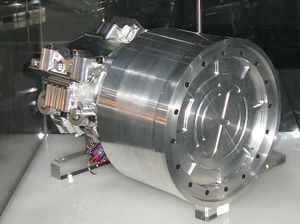Kinetic energy recovery system

Kinetic energy recovery systems (KERS) are systems used in Formula 1 vehicles (ex. a race car) in order to recover kinetic energy for future use. It works by converting the energy of motion when the car decelerates (which would've been lost as heat without a recovery system)[2] into electrical energy which is stored in a battery, supercapacitor,[3] or as mechanical energy in a flywheel.[4] The driver can then press a button on their steering wheel, discharging the battery to motion of the drive shaft and giving their vehicle a boost of power.
KERS uses three main components to do its job:
- a Motor/Generator Unit (MGU): this converts mechanical energy into electricity and vice versa.
- Power Control Unit (PCU): controls the switching of electric current between the MGU and the battery.
- Storage device: which can be any of those mentioned above (battery, supercapacitor, flywheel).
The KERS uses a "charge cycle" and a "boost cycle"—the former occurring upon deceleration in order to store the kinetic energy, and the latter occurring when the driver presses the KERS button.[3]
The battery is allowed to store 400 kilojoules (111 watt-hours) per lap, giving Formula 1 drivers 82 horsepower to use for 6.6 seconds each lap.[4]
The schematic below shows how a kinetic energy recovery system works.

For Further Reading
For further information please see the related pages below:
- Regenerative braking
- Fuel efficiency
- Torque
- Drive train (there's a fun video explaining differentials there)
- Drive shaft
- Or explore a random page
References
- ↑ Wikimedia Commons [Online]. Available: http://en.wikipedia.org/wiki/Kinetic_energy_recovery_system#/media/File:Flybrid_Systems_Kinetic_Energy_Recovery_System.jpg
- ↑ Top Gear, Why we need cars with KERS [Online], Available: http://www.topgear.com/uk/car-news/volvo-kers-driven-2014-3-25
- ↑ 3.0 3.1 Harsh Gupta via slideshare, Kinetic Energy Recovery System (KERS) [Online], Available: http://www.slideshare.net/harshgupta161/kinetic-energy-recovery-system-kers
- ↑ 4.0 4.1 Gizmag, Formula One KERS explained [Online], Available: http://www.gizmag.com/formula-one-kers/11324/
- ↑ By This image has been created during "DensityDesign Integrated Course Final Synthesis Studio" at Polytechnic University of Milan, organized by DensityDesign Research Lab in 2015. Image is released under CC-BY-SA licence. Attribution goes to "Rodolfo Riva, DensityDesign Research Lab". [CC BY-SA 4.0 (https://creativecommons.org/licenses/by-sa/4.0)], from Wikimedia Commons

